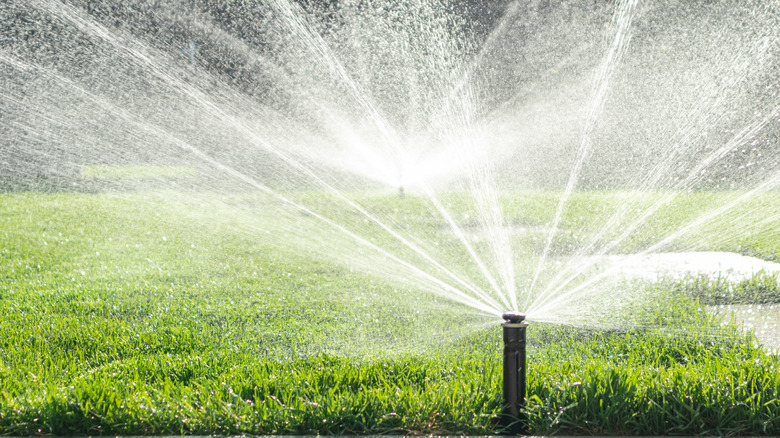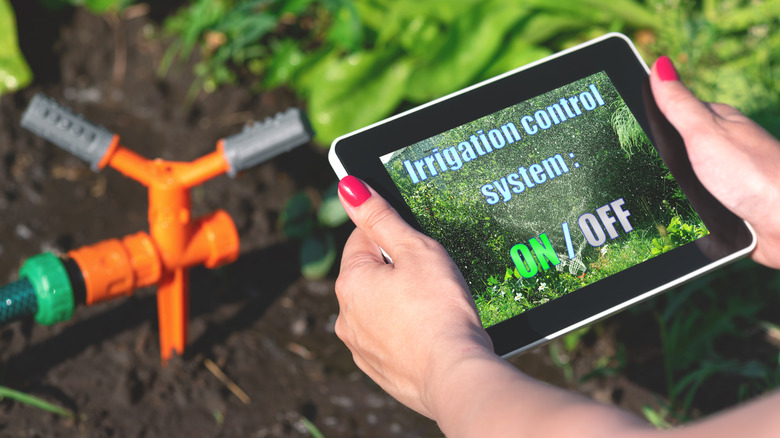We Bet You're Making A Common Mistake With Your Lawn Irrigation System
The beginning of the fertile season is characterized by freshly cut grass when the snow melts off the ground, spring takes hold, and the lovely green lawns start to emerge. The staple of the season is endless, lush greenery in front of suburban houses and the sound of automatic sprinklers keeping the grass watered and nourished. During the lawn season, the state of your irrigation system is imperative because you don't want to be the only house on the block with dying grass. As much as the concern for a healthy green lawn is heightened, people often and unknowingly make a common mistake with their irrigation systems.
Lawn sprinklers are incredibly useful in saving you water and time, maintaining the water level of the soil, and doing so regularly, but that doesn't mean that you should leave the irrigation system's settings on autopilot. While you are scrambling with your neighbors to have the best lawn in the neighborhood, you also have to ensure your sprinklers are set to deliver the appropriate amount of water for your land.
Set your irrigation system's settings to match the weather
In the quest for a plush, gorgeous lawn, it's not enough to invest in an irrigation system and then leave it to run at the same rate throughout the seasons. A mistake that a lot of people tend to make is forgetting to update the settings of their lawn irrigation systems as the seasons change. Water is life, we know, but too much of a good thing can easily hit you where it hurts. Because some seasons are dry and others rainy, your lawn would require different amounts of water as the weather changes.
Your lawn irrigation system should be reset every month. This will give it an allowance for better coverage during the drier seasons and also reduce its impact on the wet seasons. For those who don't know how much water you need to maintain your lawn, you should be giving it anything from one to 1.5 inches of water every week in the hotter months.
During spring, the rain gets pretty heavy and frequent, and, coupled with sprinklers, your lawn can easily get overwatered. You probably didn't realize this, but watering your lawn every day isn't ideal and will cause the grass to become malnourished because all those vital nutrients in the soil get leached away.
Ensuring your lawn gets the right amount of water
On the topic of overwatering your lawn, there is a cool hack to finding out if the grass needs water or if you can skip it for the day. The CEO of Willis Lawn, Brendon Willis, revealed to Homes and Gardens that if you are unsure about irrigating your lawn, all you need to do is ram a screwdriver into the ground. "If your screwdriver is able to penetrate 3-4 inches into the ground," he said, "wait another day or two to water."
When it comes to keeping your lawn mean and green, you should also avoid watering it at any old time of the day. TikTok lawn page @trugreen_lawncare_uk warns against watering during the heat of midday because the action of the sun against the water could end up damaging the leaves. Apparently, there is an optimal time for watering your lawn, and it's in the morning. "Watering at the early hours of the morning is ideal to allow any water to be absorbed through the roots before the temperatures rise to a level where the water will be lost to evaporation," the voiceover explained. You can also choose to irrigate the lawn in the early evening instead.
All in all, make sure your irrigation system is set to the correct weather, your watering is evenly spaced and at the correct time of day, and you are a few steps closer to developing a lawn that'll make all your neighbors green with envy.

